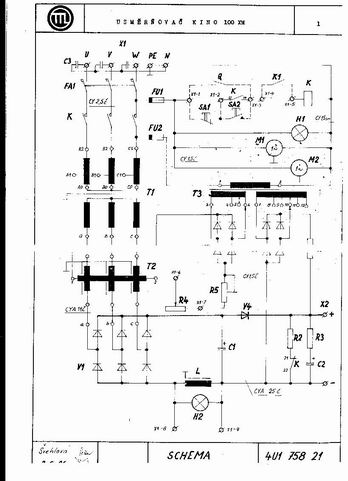|
|
This topic comprises 2 pages: 1 2
|
|
Author
|
Topic: Meopta Rectifier Schematic Question
|
|
|
Steve Guttag
We forgot the crackers Gromit!!!

Posts: 12814
From: Annapolis, MD
Registered: Dec 1999
|
 posted 09-24-2006 08:24 PM
posted 09-24-2006 08:24 PM




Your schematic is very crude in the resolution it was uploaded....
However, Diode V4 is a blocking diode to allow the boost function to work for lamp ignition. Since the boost circuit will charge to a higher voltage to trigger an auto-ignite system (typically 85VDC or higher, the diode will become reversed biased to keep the main supply that is operating closer to 25VDC off line until the arc is established. Once the lamp ignites and the arc is going, the current will cause the Diode V4 to be forward biased so the main supply is powering the lamp...in the event the lamp flames out (cold, worn out...etc), the boost circuit will once again charge things up to a higher voltage due to V4.
C2 is, no doubt a large capacitor or a multiple capacitors that form a large capacitor. Capacitance ranges a bit from 6000uF up to 3 times that, depending on that design. Due to the nature of capacitors and how charges flow through them, a capacitor that is not charged appears as a dead short once current is applied...as the charge fills up the capacitor, its impedence tends towards an open circuit. However, to avoid this short circuit appearance, R3, probably a high-wattage but low resistance resistor is there to buffer the short when the contactor turns on.
C1 is probably a very low value capacitor...probably on the order of .01uF or so whose purpose is to shunt off any high frequency noise and spikes. Should it have a resistor? If you follow math and electronic theory, the answer is yes. however, any resistance will reduce the effectiveness of it functioning as a surge/spike supressor. Practical applications dictate that the resistor is omitted. In fact, many rectifier manufacturers omit the resistor that feeds the main capacitor(s)....better designs don't do that.
R2 most likely bleeds the charge on the capacitor. Most designs do not have a relay to switch the bleed resistor out since a bleed resistor need not be very low in resistance...5K-10K will do. The idea is to drain the charge away...it need not be instantly...just in a reasonably amount of time to avoid someone from being shocked.
| IP: Logged
|
|
|
|
|
|
|
|
|
|
|
|
|
|
|
|
|
|
|
|
|
|
|
|
|
|
|
|
|
|
All times are Central (GMT -6:00)
|
This topic comprises 2 pages: 1 2
|
Powered by Infopop Corporation
UBB.classicTM
6.3.1.2
The Film-Tech Forums are designed for various members related to the cinema industry to express their opinions, viewpoints and testimonials on various products, services and events based upon speculation, personal knowledge and factual information through use, therefore all views represented here allow no liability upon the publishers of this web site and the owners of said views assume no liability for any ill will resulting from these postings. The posts made here are for educational as well as entertainment purposes and as such anyone viewing this portion of the website must accept these views as statements of the author of that opinion
and agrees to release the authors from any and all liability.
|

 Home
Home
 Products
Products
 Store
Store
 Forum
Forum
 Warehouse
Warehouse
 Contact Us
Contact Us




 Printer-friendly view of this topic
Printer-friendly view of this topic











![[Big Grin]](biggrin.gif)




